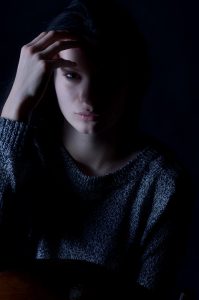Table of Contents
Common Types of Depression and Their Symptoms
There are many types of depression, and all of them share the same similitude: sadness, hopelessness, loss of motivation, and loss of confidence. Losing interest or pleasure, while having a feeling of guilt, is also often experienced by depressed individuals. However, the disease should not be taken for sadness or a temporary malaise.
The term depression is often incorrectly used in everyday language to describe the inevitable periods of sadness, boredom and melancholy that we all experience in life at one time or another. This is not clinical depression. Being sad after the loss of a loved one or having a sense of failure in case of serious problems or a medical condition (cancer for instance) is quite normal.
What types of depression that needs treatment?
 Most types of depression can disappear on their own, depending on the circumstance. The problem becomes a mental disorder when these mental disorders persist or keep coming back every day for no particular reasons or overly persistent. Besides the sadness, the depressed person maintains negative thoughts that worsen the situation day by day.
Most types of depression can disappear on their own, depending on the circumstance. The problem becomes a mental disorder when these mental disorders persist or keep coming back every day for no particular reasons or overly persistent. Besides the sadness, the depressed person maintains negative thoughts that worsen the situation day by day.
The patient may also feel worthless and unable to plan for the future. He has no interest in activities previously enjoyed. Sometimes, the depression symptoms include unreasonable irritation (exacerbation). In this case, treatment is important.
Depression is a serious chronic illness which responds to specific diagnostic criteria and treatment options. The treatment recommended differs depending on the severity of the symptoms.
How to know you are clinically depressed?
Depression usually occurs in the form of periods of depressive disorder that can last from 2 weeks to several years, even a lifetime. The disease not only affects mood, thoughts and behavior, but also the organic functions. This explains why a clinically depressed person tends to be vulnerable to colds and other infections; the immune system is weakened.
Common Types of Depression
 Depending on the intensity of the symptoms, depression is described as mild, moderate or severe. Depending on the severity or the characteristic of the symptoms, depression is grouped into several types of which the most common include:
Depending on the intensity of the symptoms, depression is described as mild, moderate or severe. Depending on the severity or the characteristic of the symptoms, depression is grouped into several types of which the most common include:
Clinical Depression (also known as Major Depression or MDD) – This is one of the most serious types of depression. If you have been diagnosed with it, you have high chance to experience symptoms that last all day, nearly every day and for at least two weeks straight. In addition, you will have at least 2 of the following symptoms:
- depressed mood
- no or poor interest in almost everything
- slowness or fatigue
- loss of energy
- difficulty to concentrate or focus
- Suicidal thoughts.
You can see Clinical Depression for more info
Dysthymic Depression (Also known as Neurotic Depression or Dysthymic Disorder) – Dysthymic is more persistent than major depression, but the symptoms tend to be less severe. People with dysthymic disorder, usually have depressed mood for at least two years and have 2 or more of these symptoms:
- gain or loss of appetite
- sleep problems: oversleeping or lack of sleep (insomnia)
- unreasonable fatigue
- low self esteem
- distracted or unable to concentrate
- Feeling hopeless.
 Manic Depression (Bipolar Disorder or Bipolar Affective Disorder) – It is important to know that the terms manic depression disorder and manic-depressive disorder are very rarely used in the medical community but bipolar disorder. The condition includes obsession and depression; switching between these two states can be rapid, but rarely present at the same time. The symptoms last for at least one week, and can be so severe that health professionals should take necessary measures to calm down the patient in order to avoid injuries, family members or health care providers. This is one of the most dangerous types of depression.
Manic Depression (Bipolar Disorder or Bipolar Affective Disorder) – It is important to know that the terms manic depression disorder and manic-depressive disorder are very rarely used in the medical community but bipolar disorder. The condition includes obsession and depression; switching between these two states can be rapid, but rarely present at the same time. The symptoms last for at least one week, and can be so severe that health professionals should take necessary measures to calm down the patient in order to avoid injuries, family members or health care providers. This is one of the most dangerous types of depression.
Common symptoms associated with Bipolar Disorder (Manic Depression) include:
- exaggerated sense of self–importance
- become more talkative than usual
- false or distorted perception of objects or events with a compelling sense of their reality (hallucinating)
- prolonged sleep problems such as early-morning awakening, or oversleeping
- experiencing racing thoughts and ideas associated with irritability and restlessness
- Increase of goal-orientation (work, school, sexual behavior)
- tendency to enjoy risky pleasures and behaviors
- decreased appetite and/or weight loss, or overeating and weight gain
- difficulty concentrating, remembering, and making decisions
- fatigue associated with decreased energy and slowness
- unreasonable feelings of guilt, worthlessness, helplessness
- loss of interest or pleasure in hobbies and normal activities including sex
- Persistent physical symptoms that do not respond to appropriate treatment: headaches, digestive disorders, chronic pain and others
- Thoughts of death or suicide, suicide attempts.
Postpartum Depression (also called PPD or Postnatal Depression) – This is a moderate to severe kind of depression that is diagnosed mostly in women. The symptoms usually occur within the first few months after delivery – mainly after delivery and up to a year later. The disorder is caused by sudden changes in the woman’s hormones. Common Postpartum Depression Symptoms include:
- severe mood swing
- loss of appetite
- lack of joy in life
- sleep problem or Insomnia
- intense irritability and anger
- overwhelming fatigue
- loss of interest in normal things of life such as sexual intercourse sex
- feelings of shame, guilt or inadequacy
- difficulty bonding with the baby
- withdrawal from family and friends
- Unreason thoughts of harming yourself or the baby.
Psychotic Depression [or Psychotic major depression (PMD)] – 
- Severe insomnia
- Serious irritability
- Severe agitation
- Severe anxiety
- Physical immobility
- Bowel problems constipation for instance
- Unshakable belief in something untrue (Delusions)
- excessive preoccupying fear of having a serious illness (Hypochondria)
- Decreased or slower rate of ability to communicate, interact, study, work, and establish independence (Intellectual impairment).
- False or distorted perception of objects or events with a compelling sense of their reality (hallucinating).
Adjustment Depression (Adjustment Disorder or Situational Depression) – This kind of depression tends to be short-term, and occurs mainly in people who have been through severe life crisis (serious illness for instance), major life change (getting married, having a baby…) or loss (losing a job or a loved one for instance), or any kind of near death experience. The fact the disorder is triggered by an outside event it generally disappears once the person has control over the situation.
Most situational depressions do not require medical treatment. Some common symptoms of the disease include tearfulness, feelings of hopelessness, and loss of interest in normal activities of life. Adjustment Disorder and seasonal affective disorder are the 2 less severe types of depression.
Seasonal Affective Depression or Seasonal Affective Disorder (SAD) – This is a non-severe depression caused by seasonal changes; that is why the condition is sometimes called winter depression, winter blues, summer depression, summer blues, or seasonal depression. SAD symptoms tend to start in the fall and continue into the winter months, causing a decreased energy and moody change. The seasons play a major role in the characteristic of seasonal affective disorder symptoms. For instance:
Fall and winter seasonal affective disorder symptoms include:
- feeling of hopelessness
- anxiety
- oversleeping
- loss of energy
- weight gain
- difficulty concentrating
- heavy, leaden feeling in the arms or legs
- social withdrawal
- loss of interest in normal activities the patient once enjoyed
- Appetite changes characterized by craving for foods high in carbohydrates.
Spring and summer seasonal affective disorder symptoms include:
- anxiety
- increased sex drive
- sleeplessness (insomnia)
- irritability and/or agitation
- Poor appetite which leads to weight loss.
Unspecified Depressions – These types of depression have symptoms similar to major depressive disorder, but not severe enough to be qualified as major depression. It also includes moderate, chronic depression which has not been presented long enough to be qualified as dysthymic depression. Symptoms may include any of the depression symptoms above.



